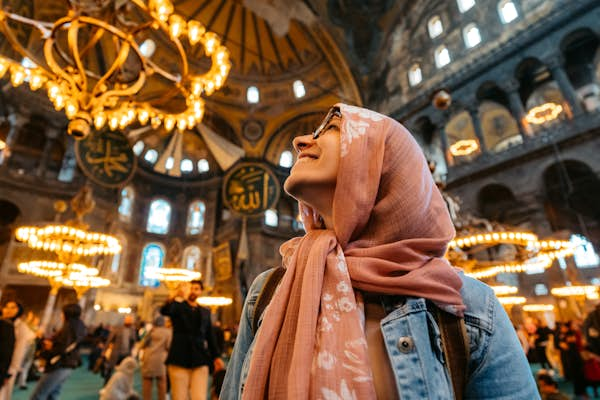İstanbul’s iconic Hagia Sophia has new rules for visitors: here's what you need to know
The Hagia Sophia in İstanbul has reopened its upper gallery for the first time since 2020 – but with new rules and a fee.

The Hagia Sophia in İstanbul has reopened its upper gallery for the first time since 2020 – but with new rules and a hefty entrance fee.
Home to some glorious Byzantine-era mosaics, the upper gallery of İstanbul's Hagia Sophia has reopened to visitors for the first time since 2020. However, access to other parts of the historic building has been significantly reduced for foreign travelers.
As well as being charged a hefty new €25 entrance fee, tourists and non-Muslims can no longer visit most of the ground floor. This is after the 6th-century cathedral, which has previously been used as a mosque and a museum, was converted back into a mosque by President Erdoğan of Türkiye four years ago.
For the last few years, Hagia Sophia has struggled with overtourism. It was already one of İstanbul’s most popular tourist sights but when it was converted into a mosque again, entry became free.
As a result, visitor numbers skyrocketed. According to government officials, they rose from 3.7 million in 2019 to 13.6 million in 2022. People queued for one-to-two hours to enter and there were reports of vandalism and other damage caused by the volume of visitors.
“Hagia Sophia is an old structure and it was getting much too crowded,” said Cihancan Sezgin, a licensed tour guide based in İstanbul.
“The new entrance fee is high, especially for Turks, but for the building itself the new system is much better than it was the past few years. We’ll have to wait until summer to see how things are going to be in high season,” he added.
The ancient mosque has been damaged and repaired after multiple earthquakes and fires © Jennifer HattamWhat are the new rules for visiting Hagia Sophia?
As of January 15, 2024, Hagia Sophia now has two entrances. The one on Sultanahmet Square is now exclusively for Turkish citizens visiting the worship area (ibadet alanı) in the former narthex and nave.
However, when Lonely Planet visited, guards at the entrance were confused as to whether non-Turkish Muslim visitors could enter this area to pray. Many think the new rules will take time to bed in.
People from “Other Nationalities,” should go to the “Visiting Area” entrance at the northeast corner of the building. A new ticket booth has been set up in front of the Fountain of Sultan Ahmet III. All visitors over the age of 8 now must buy a ticket for €25 (or 850 TL).
Women visitors must also wear a headscarf before they pass through a temporary entrance and ascend a stone ramp to the upper gallery. They are available to buy near the worship area entrance for 30 TL.
Downstairs at the Hagia Sophia Grand Mosque, Istanbul © Ayhan Altun / Getty ImagesWhat parts of the Hagia Sophia are now off-limits for foreign visitors?
After making a loop through the upper gallery, visitors will descend a set of stairs to the southwest vestibule.
Here, they can see the 10th-century mosaic that depicts emperors Justinian and Constantine presenting Hagia Sophia and the city of Constantinople to Mary and the Christ child.
The doorway below the mosaic was where the Byzantine emperor entered the inner narthex. Previously, foreign visitors were allowed to enter but the new rules mean that they must exit the building at this point.
This change means visitors will miss out on one of Hagia Sophia’s finest mosaics depicting Emperor Leo IV bowing at the feet of Christ. The oak-and-brass Imperial Door, a close-up of the rich marble-paneled walls and the omphalion where Byzantine emperors were crowned are also out of bounds.
Tour guide Sezgin thinks that’s a loss.
“You miss that feeling when you step into the nave and look up at the magnificent dome,” he said. “That sense of how small you are was just the best.”
Visitors now use audio guides in the upper gallery of the mosque as guides are not permitted © Jennifer HattamWhat is there to see in the Hagia Sophia upper gallery?
Under the new rules, professional guides are no longer allowed to give tours inside the Hagia Sophia.
Instead, visitors can scan a QR code on their phone to access an audio-visual tour (headsets are an additional 100 TL/€3 but you can use your own).
The tour offers some details on 10 points of interest in 23 different languages. Nine of these are in the upper gallery, including the marble door dubbed the ‘Heaven and Hell Gate’; the 11th-century graffiti known as the Viking Script; and the mosaic of Constantine IX and Empress Zoe.
The monumental Deësis mosaic depicting the Virgin Mary, Jesus Christ and John the Baptist is in the upper gallery, too.
The new entrance to the Hagia Sophia for foreign visitors with restoration work continuing © Jennifer HattamCharging non-Muslims to visit the Hagia Sophia isn’t a new idea
Sedat Bornovalı, an Istanbul-based art historian and author of the book Tarihin En Uzun Şiiri: Ayasofya (History’s Longest Poem: Hagia Sophia) says charging non-Muslims to visit is not a new idea.
“We can see from documents in the Ottoman archives that tickets to the upper gallery of Hagia Sophia were sold to foreign visitors in those days,” he said.
“It is a pity they now cannot proceed further into the building’s interior,” he added. “Insisting that one can only enter [the downstairs] to pray is unnecessary and unsustainable.”
Ottoman archives show charging non-Muslims to visit is not a new idea © Jennifer HattamWhy is Hagia Sophia so important?
Originally commissioned by Byzantine Emperor Justinian and consecrated in 537 as a Christian basilica, the Hagia Sophia is an architectural and engineering masterpiece.
Topped by a 56m (184ft) high central dome, its grandeur was not surpassed for almost a millennia and inspired the Ottoman-era imperial mosques that mark the city’s skyline today. The building also symbolizes the centuries of history that have shaped it – and İstanbul and Turkey more broadly.
Damaged and repaired after multiple earthquakes and fires, it was sacked during the Fourth Crusade in 1204 and briefly turned into a Latin Catholic cathedral. It then returned to Byzantine control before Ottoman armies finally breached the walls of Constantinople in 1453 after a long siege.
Three days after that military victory, the Hagia Sophia was hosting Friday prayers as a mosque on orders of conquering Sultan Mehmed II. Hagia Sophia remained a mosque for more than four and a half centuries of Ottoman rule, during which minarets and calligraphic panels were added to the building.
After he established the Turkish Republic, founding President Atatürk turned it into a museum in 1935 as part of his secularization policy agenda.
Almost a century later, President Erdoğan controversially ordered that the Hagia Sophia be reconverted into a mosque. The Ayasofya-i Kebir Cami-i Şerifi (Hagia Sophia Grand Mosque) opened for Muslim prayers on 24 July 2020.
Turquoise carpets now cover the marble floor of its former nave and screens shroud some of its Christian iconography, including the iconic apse mosaic of the Virgin Mary and Christ child.





















